General election 2019: The campaign's most controversial numbers
- Published
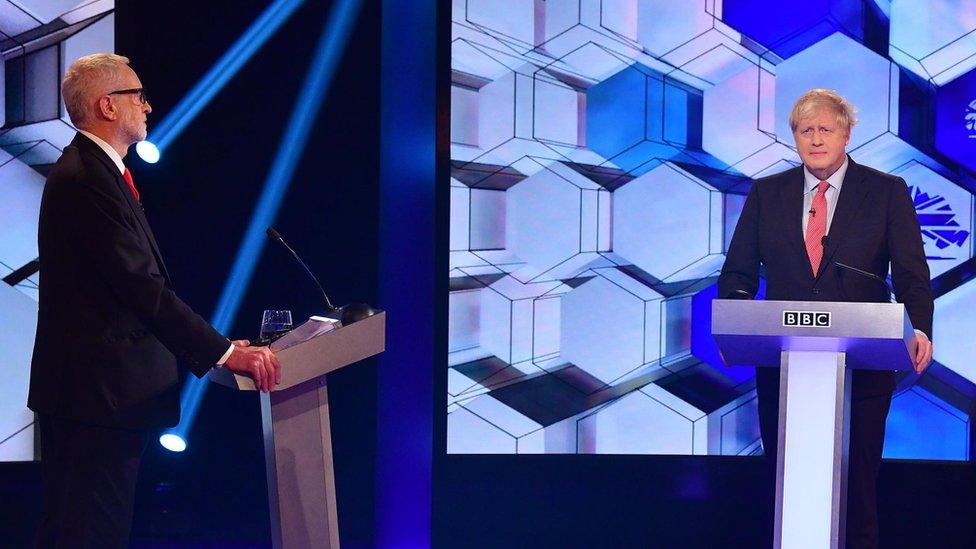
The Reality Check team navigates the most questionable figures that have cropped up in the election campaign.
£1.2 trillion
One of the biggest numbers to come out of the campaign so far was £1.2tn, which was the extra amount the Conservative Party said that Labour would spend over the next five years.
The initial verdict on this was that the Conservatives could not possibly know this because the Labour manifesto had not yet been published.
The dossier, external was released on 10 November, well before the Labour manifesto, external was published on 21 November.
Now that we do have the manifesto, we can make a list of some of the items that were included in the Conservative costing that were not included, together with how much the Tories said they would cost over five years.
Abolishing private schools - £35bn
Free school meals for secondary school students - £6.8bn
Excluding pensions from the 2% target for defence spending - £3bn
That's nearly £45bn.

Some of the Conservative costings also seemed somewhat inflated. For example, they used the figure of £196bn (from the Confederation of British Industry) as the cost of nationalisation, which is hotly contested. It assumed that a Labour government would pay a 30% premium above the market value of the assets it wanted to nationalise. On the other hand, it came before the announcement of the plan to nationalise part of BT.
Even if you accept that costing, a rough overall calculation comes up well short.
Labour has committed to a National Transformation Fund, which will invest £55bn a year over the next five years on things like housing and green projects.
Its manifesto costings "grey book" says it will be spending another £83bn a year on day-to-day spending, by the fifth year of the parliament.
Even if you assume that it spends that much every year (£415bn over five years), add £275bn for five years of investment, £196bn for nationalisation and £58bn to compensate Waspi women, you still come up more than quarter of a trillion pounds short of the Conservative figure.
The Conservatives used the £1.2tn figure to come up with an estimate that the extra spending would cost the average taxpayer an extra £2,400 a year, which is similarly dubious.
That's partly because its starting point was the £1.2tn claim, and also because there were additions such as the claim that Labour is considering a homes tax, which would cost households up to £375 more than the current Council Tax system, raising an extra £10.2bn.
However, this seems to be based on a policy-proposal document put forward by Guardian columnist George Monbiot in June, and commissioned for the Labour Party. It did not appear in the manifesto.
Claims about the cost of Labour's spending have featured heavily in Conservative adverts on social media.
The £1.2tn and/or £2,400 figures have appeared in more than 600 ads on Facebook, Instagram, Google and YouTube. An approximate collective reach of these adverts amounts to at least one million users.
£500m a week
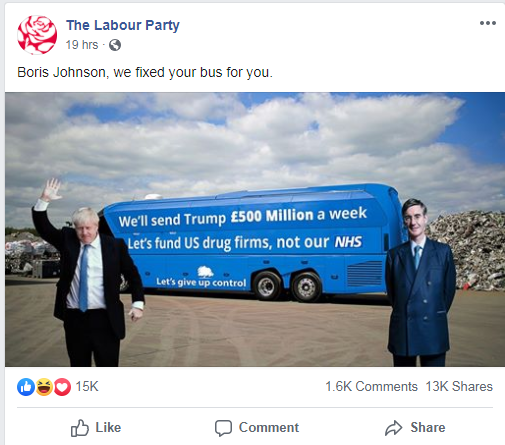
The Labour Party used the figure in a post on its official Facebook page
Labour claimed that a Conservative trade deal with the US would mean the NHS having to spend an extra £500m a week on drugs.
The party even mocked up a picture of a bus on its Facebook page, with Boris Johnson and Jacob Rees-Mogg standing in front of it, saying: "We'll send Trump £500m a week. Let's fund US drug firms, not our NHS."
The figure comes from an academic study which looked at how much more the US pays for drugs, per head, than the UK - about 2.5 times more, according to the OECD.
But the report's authors described it as "a crude estimate" and "a worst-case scenario" - not an attempt to work out how much the NHS could actually spend on drugs, after a UK/US trade deal.
At the moment, according to the Office for National Statistics, 9% of all medicines imported by the NHS come directly from the US, while 79% of medicine imports come from the European Union.
That may be an underestimate of US imports, on the grounds that some US pharmaceutical companies may be selling drugs to the UK via their European subsidiaries.
Nonetheless, while it is possible that a UK trade deal with the US could lead to the NHS paying higher prices for drugs from the US, it is highly unlikely that those higher prices would also be paid for drugs coming from the EU, and indeed for the ones made in the UK.
After the figure was widely questioned, Labour figures generally stopped using it. Although the £500m claim has not been widely promoted in Labour's digital adverts, an ad featuring the figure, which ran on Facebook and Instagram early in the campaign, has been shown between 175,000 and 200,000 times.
40 new hospitals
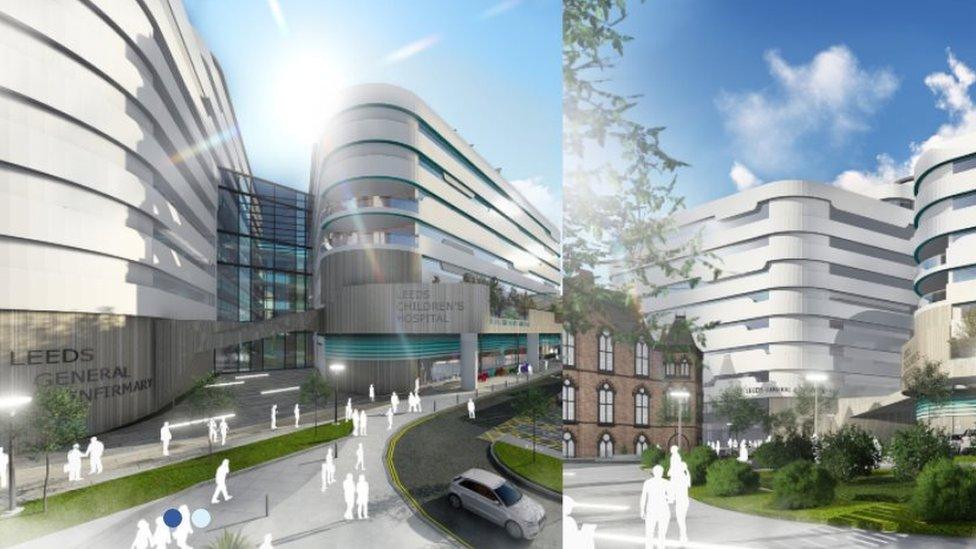
Leeds General Infirmary will be one of the first six funded projects
The prime minister has repeatedly pledged to build 40 new hospitals over 10 years. The Conservative manifesto went as far as to say the party was proud "to have begun work on building 40 new hospitals across the country".
But while the plans include a £2.7bn investment for six hospitals over five years, a further 34 hospitals will share only an initial £100m in funding to start developing future projects.
A substantial amount of extra money would be needed to bring those plans to fruition.
And there is some question about whether even the six initially funded ones are actually new hospitals, or refurbishments, or additions to existing ones. Either way, building work hasn't yet begun at these sites - as Reality Check reported.
Also, Radio 4's More or Less found that 12 of the remaining 34 hospitals would be community hospitals in Dorset, which are relatively small hospitals - what used to be called cottage hospitals, and perhaps not what people would have been thinking about when Mr Johnson talked about 40 new hospitals.
The £6,000 increase in household bills
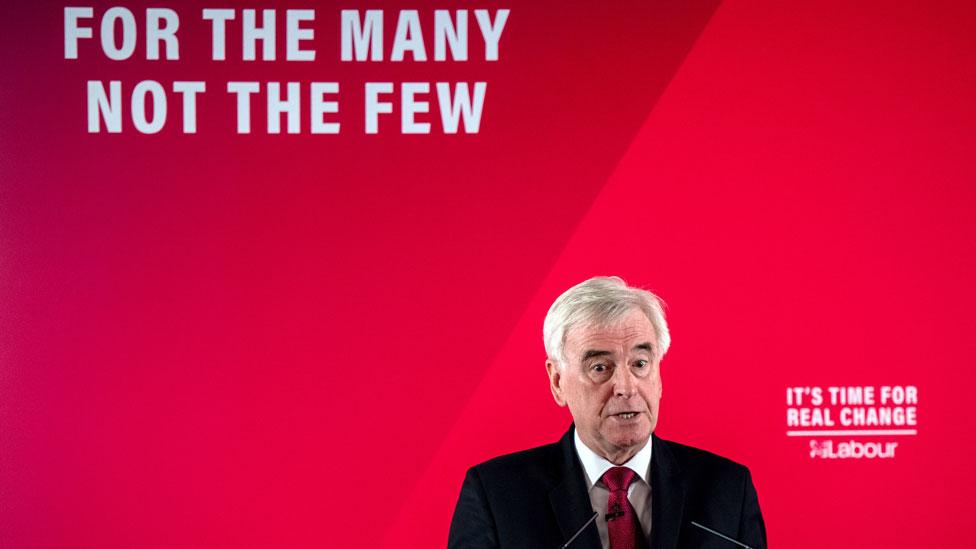
Labour said the Conservatives' failure to curb household bills had cost the average household almost £6,000 a year since 2010.
These are all based on figures for rising bills for things like prescriptions, broadband and rail tickets, even though some of the items on the list have gone up less than the rate of inflation, which means their prices were rising less than the price of a typical "basket" of goods and services.
Also, the household that has lost out by £6,000 is quite a specific one, having two adults who buy annual rail season tickets and a two-year-old child, which is not necessarily representative.
And Labour said that the cost was £6,000 a year since 2010, but its calculations were for the increased costs in the final year. Clearly the price rises, even for this specific household, would have been considerably smaller in 2011, for example.
Five million Labour Leavers
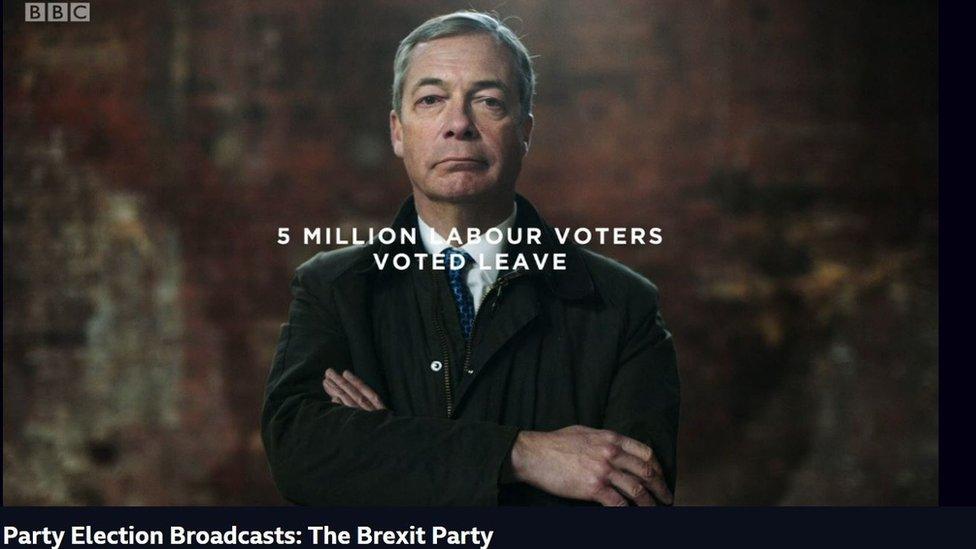
Nigel Farage keeps saying he is targeting the five million people who voted Leave in 2016 and voted Labour in 2017.
We don't have precise figures for this because both were secret ballots, but a number of respected organisations have conducted large surveys looking into this.
Most estimates fall between three million and four million. Even the top of the margin of error of the highest estimate does not get to five million.
The 5m figure was mentioned in a Brexit Party election broadcast that aired on the BBC, and Facebook ads promoting the same broadcast have been shown to users more than 500,000 times. Facebook ads targeting Labour seats - from Bootle to Bassetlaw - also included the figure.
The numbers in certain bar charts

This chart was posted on the Bath and North East Somerset Liberal Democrats' Twitter feed.
It makes it look as if it's a close race between the Conservatives and the Lib Dems.
Read the small print, however, and it turns out this reflects a Survation poll of only 405 people asked the leading question: "Imagine that the result in your constituency was expected to be very close between the Conservative and Liberal Democrat candidate and none of the other parties were competitive. In this scenario, which party would you vote for?"
And Labour still had 8% support.


What are the parties promising you?
Use this concise guide to compare where the parties stand on key issues like Brexit, education and the NHS.

Follow election night on the BBC
Watch the election night special with Huw Edwards from 21:55 GMT on BBC One, the BBC News Channel, iPlayer
As polls close at 22:00, the BBC will publish an exit poll across all its platforms, including @bbcbreaking, external and @bbcpolitics, external
The BBC News website and app will bring you live coverage and the latest analysis throughout the night
We will feature results for every constituency as they come in with a postcode search, map and scoreboards
Follow @bbcelection, external for every constituency result
From 21:45 GMT, Jim Naughtie and Emma Barnett will host live election night coverage on BBC Radio 4, with BBC Radio 5 live joining for a simulcast from midnight


